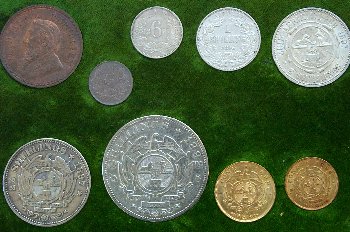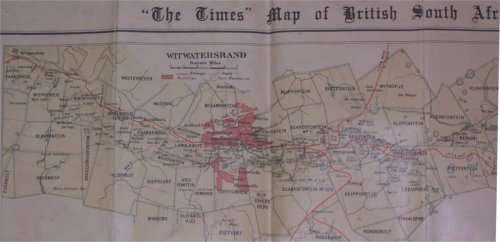 Background of the "Kruger Coinage"
Background of the "Kruger Coinage"
 Background of the "Kruger Coinage"
Background of the "Kruger Coinage"
The ZAR encompassed a region known as the Transvaal. Dissatisfied with British rule of the Cape Colony, the Boers (Dutch Afrikaaners) embarked on what became known as the Great Trek of 1835-43, re-establishing themselves in the interior of the country and displacing the Griqua people around Kimberley in the Orange Free State. There they created the ZAR in 1852 and the Orange Free State in 1854. This migration is commemorated with the image of a Voortrekker wagon, which appears on many South African coins including the one-pound and half-pound pieces of 1892-1900.
The economy of the ZAR was primarily agricultural until the discovery of diamonds in 1867 and gold on the Witwatersrand (see map below) during the 1880s prompted a flood of "Outlander" prospectors and "Outlander" speculative investment. Despite a series of boom and bust cycles, the general trend was toward increasing prosperity and the discovery of gold saved the evolving boer republic from bankruptcy in the 1870s. So much wealth required a central banking system, and De Nationale Bank der Zuid-Afrikaansche Republiek was opened by the Republic’s President Paul Kruger in 1891. The bank prospered, and the passage of a Mint Act that same year provided for a coinage of gold, silver and bronze modeled after that of Great Britain. Ironically the gold mining district of the Witwatersrand was bought up by mainly British "Outlanders" but including the infamous and fabulously wealthy Barney Barnato who had earlier been outwitted by the dynamic Cecil Rhodes over the acquisition by De Beers of the great hole of Kimberley and its diamonds from dozens of small prospectors. More on Barney Barnato at this link, and Cecil Rhodes at this link.
The State Mint and National Bank shared a building in Church Square in Pretoria - a city which was but a shadow of the main gold mining industrial hub - centered around Johannesburg. In the map below you can see details of the major properties forming the golden reef around Johannesburg.
The Balson Holdings Family Trust holds
The Times War
Map of South Africa 1899
This very large map is cast in linen and in very good condition (no holes)

Included in the new coinage were two gold pieces. The one-pound and half-pound coins were similar in values and specifications to the English sovereign and half sovereign, respectively. Because the ZAR did not have a monarch, these particular titles were not used. Instead, the coins were referred to by their value alone, and they possessed unlimited legal tender status within the ZAR. Though this status was not recognized elsewhere, the intrinsic value of these coins permitted them to circulate freely in other parts of South Africa.
President Kruger’s portrait appeared on each coin’s obverse, with the country’s name in Afrikaans inscribed in an arc around the periphery. The reverse of the pound and half pound coins displayed the arms of the ZAR, with the coin’s value and the date of coinage arranged in an arc above. The Dutch motto Eendragt Maakt Magt (Union makes strength) is incorporated into the arms.
Once again it was ironic that the boers in the new republic had stigmatised the wealthy "Outlanders" centered in Johannesburg by not allowing them, like the black indigenous population, to vote. It was this disenfranchisement and the heavy taxes that they had to pay to support a hunting and rural boer population led by Paul Kruger that led to the boer war in 1899.
Personal reflection on the ZAR Coins
 The Paul Kruger coins issued by the independent Afrikaner
states have always intrigued me.
The Paul Kruger coins issued by the independent Afrikaner
states have always intrigued me.
Not so much because of the age, geography or people who used them but the events that were unfolding around them.
Where they displaced the Griquas in the region now known as the Orange Free State and the Transvaal, the British soon followed pursuing the same riches as these pioneering whites of Dutch heritage - the wealth inherent with the fortune in gold under the ground in the region known as the Witwatersrand.
All coins shown from the Balson Holdings Family Trust collection above are VF+ and the set has an estimated value of about US$500.
The boers also minted the famous Veld Pond which was issued in the field of war.
The mintage of the different ZAR coins - and notes
Value in 2005: The Paul Kruger ZAR coinage are sought after - valued at from just a few dollars. Often seen on auction.
Pres Burgers
[1872: Zuid Afrikaansche Republiek (ZAR)
£1 Note] [1874: Coarse Beard Burgers Pond] [1874: ZAR Patterns]
Pres Paul Kruger
[1892 Double Shafted Coins] [1892
- 1900: ZAR Paul Kruger Coins] [OFS Postal
Notes]
[1900 Pretoria Bank Notes] [1901
Pietersburg Bank Notes] [1902 Te Velde Bank
Notes] [Boer POW notes]
[1902: Veld Pond] [ZAR
Coins tampered with by Boer and British Prisoners of War (POWs)]
Boer War Siege notes and exonumia
[1893 Bechuanaland Border Police
Coins] [1899- 1900: Mafeking Siege Notes and Newspaper
Siege Slips]
[1900 Marshall Hole Bulawayo Card Currency]
Miscellaneous Exonumia
[Who is Paul Kruger]
[Title Deeds signed by Kruger]
[Lord Roberts' proclamation of Kruger's desertion
- Sept 1900]
[Contemporary Books on Boer War]
[Kruger's Unique Family Photo]
[Other Boer Coins & Medallions]
[Zuid Afrikaansche Republiek Coins and Notes]
[Web Site Text Site Map]
[Tokencoins.com Home Page]